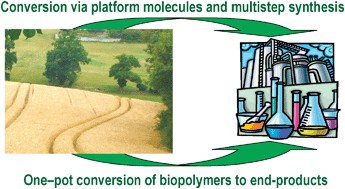This critical review provides a survey illustrated by recent references of different strategies to achieve a sustainable conversion of biomass to bioproducts. Because of the huge number of chemical products that can be potentially manufactured, a selection of starting materials and targeted chemicals has been done. Also, thermochemical conversion processes such as biomass pyrolysis or gasification as well as the synthesis of biofuels were not considered. The synthesis of chemicals by conversion of platform molecules obtained by depolymerisation and fermentation of biopolymers is presently the most widely envisioned approach. Successful catalytic conversion of these building blocks into intermediates, specialties and fine chemicals will be examined. However, the platform molecule value chain is in competition with well-optimised, cost-effective synthesis routes from fossil resources to produce chemicals that have already a market. The literature covering alternative value chains whereby biopolymers are converted in one or few steps to functional materials will be analysed. This approach which does not require the use of isolated, pure chemicals is well adapted to produce high tonnage products, such as paper additives, paints, resins, foams, surfactants, lubricants, and plasticisers. Another objective of the review was to examine critically the green character of conversion processes because using renewables as raw materials does not exempt from abiding by green chemistry principles (368 references).

You have access to this article
 Please wait while we load your content...
Something went wrong. Try again?
Please wait while we load your content...
Something went wrong. Try again?


 Please wait while we load your content...
Please wait while we load your content...